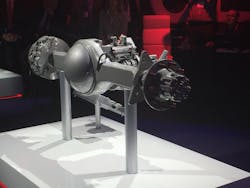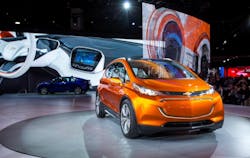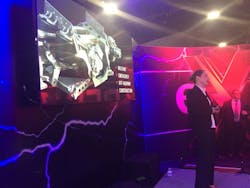Trucking is trending fast towards electrification
Manufacturers that build cars and heavy trucks alike increasingly believe electricity – whether as stand-alone power or as part of a hydrogen-based fuel cell system – will play a critical role in powering motor vehicles in the not-so-distant future.
At the recent North American Commercial Vehicle (NACV) show, Jay Craig – president and CEO of Meritor – noted that the cost of a 100 kilowatt per hour (KwH) battery pack declined from $120,000 in 2009 to $25,000 today, with predictions that costs will drop to $15,000 by 2025.
That low costs can make electricity a more affordable power solution for a heavy-duty vehicle, he explained, which is why Meritor is now developing a platform of electric drive axles and suspensions as well as supporting systems.
“Essentially, we’re focusing on integrating an electric motor into the differential carrier,” Craig said during a presentation last week at the show. "As we look to future emissions regulations and our customers’ desire for more efficiency, we’re developing new and innovative solutions to expand our product portfolio."
He added that Meritor’s flexible “e-carrier” design will be the foundation for various drivetrain configurations, including full electric, hybrid, single or tandem axles with various options based on application.
But it’s not just heavy-duty vehicles that are being redesigned with electricity in mind.
“General Motors believes in an all-electric future,” emphasized Mark Reuss, executive vice president of product development, purchasing and supply chain for General Motors this week.
“Although that future won't happen overnight, GM is committed to driving increased usage and acceptance of electric vehicles through no-compromise solutions that meet our customers' needs,” he said.
In the next 18 months, Reuss noted that GM will introduce two new all-electric vehicles based off learnings from the Chevrolet Bolt EV compact car. They will be the first of at least 20 new all-electric vehicles that will launch by 2023.
However, given customers' various needs, he aid getting to a zero emissions future will require more than just battery electric technology. It will require a two-pronged approach to electrification — battery electric and hydrogen fuel cell electric depending on the unique requirements.
That’s why GM also introduced SURUS this week, which is short for the “Silent Utility Rover Universal Superstructure.” SURUS is a fuel cell powered, four-wheel steer concept vehicle on a heavy-duty truck frame that’s driven by two electric motors.
With its capability and flexible architecture, SURUS could be used as a delivery vehicle, truck or even an ambulance — all emissions free, Reuss added.
Back where heavy-duty truck front, Craig said Meritor is focused on developing several new “electrified” products:
- An integrated two-speed electric carrier platform capable of delivering 150 to 200 kilowatts of continuous power for mounting on existing axle platforms. That will allow it to fit a wide variety of applications on rigid and independent suspensions
- A new electrified axle dubbed the “13Xe” will be a rigid axle, capable of 200 kilowatts of continuous power and featuring customizable gearing to cover linehaul, school bus, refuse, pickup and delivery, utility and other applications
- Electricity-driven independent suspensions for applications such as military, emergency, off-highway and construction vehicles that will benefit from increased performance as well as better ride comfort and handling
- An electric eCorner module for low-floor applications such as medium-duty Class 4 and 5 trucks, pickup and delivery vehicles, plus transit buses.
The company is developing air disc braking systems specifically for what it calls “e-axles,” for us in hybrid or all-electric trucks; braking packages designed to reduce weight on wheel-ends, according to Craig.
Those components will be part of a demonstration vehicle to be built in 2018, with production beginning as early as 2019.
“These emerging electric solutions reflect Meritor’s commitment to develop axle, suspension and brake technologies that support our technology roadmaps and future product plans based on our customers’ needs,” Craig said.
Meritor also highlighted several other new products and endeavors at the NACV show last week:
- The company has “optimized” its EX+ air disc brake (ADBs) for tractors and trailers to reduce product weight by 10 lbs. per brake. Those “optimized” EX+ ADBs will be available to OEMs in 2018.
- The Meritor Tire Inflation System (MTIS) for trailers will now include the ThermALERT wheel-end heat-sensing system as standard equipment beginning this month – a system that activates an indicator light when wheel-end temperatures are abnormally high. Meritor will also offer an five-year warranty without placing an additional premium on MTIS as well.
- Meritor is also offering a new “value brand” for aftermarket parts called Mach that offers global customers “all-makes” products designed and engineered to industry standards at “affordable prices.”
- Designed for second as well as third owners, Mach-branded products include an assortment of suspension, steering, brake and drivetrain components that will be available initially in North America before the end of 2017 and then will launch in Europe, South America and Australia at a later date. All of the Mach-branded parts will come standard with a one-year warranty.
About the Author
Fleet Owner Staff
Our Editorial Team
Kevin Jones, Editorial Director, Commercial Vehicle Group
Cristina Commendatore, Executive Editor
Scott Achelpohl, Managing Editor
Josh Fisher, Senior Editor
Catharine Conway, Digital Editor
Eric Van Egeren, Art Director


